|
Common names:
Australia |
English |
Weber's mudskipper |
China |
Chinese Mandarin |
韦氏弹涂鱼, 韋氏彈塗魚 (wei shi tan tu yu - Wei’s mudskipper) |
Italy |
Italian |
perioftalmo di Weber* |
Papua New Guinea, Purutu Is. |
Purutu language |
paraguamo
|
* proposed name
|
|
|
Synonyms:
|
Periophthalmus weberi |
Eggert, 1935 |
(senior synonym, original combination) |
Etymology:
'Periophthalmus' is a compound name from the Greek 'peri' (around), and 'ophthalmôn' (eye), which refers to the wide visual field of these species
this species is named after Max Weber, an eminent ichthyologist who intensively worked in the New-Guinea and Australia region
|
Maximum recorded length:
85 mm SL (Polgar et al., 2010)
100 mm SL (Allen et al., 2002)
Live colouration
(Larson, 2008; Polgar et al., 2010):
background colour light brown to greyish in females, brownish to bluish grey in mature males, ventrally paler; blue irregular stripes on chin and throat; two irregular dark irregular stripes coursing dorsally from eyes posteriorly to the caudal peduncle and 7-8 dark brown saddle bars on dorsum may be visible; in males, D1 membrane dark brown with many iridescent blue spots;
fin margin translucent to pale blue; 1st and 2nd dorsal spine whitish; in females, D1 brownish; D2 proximally dark brown with blue spots on membrane, a white inframarginal stripe, and a red margin;
caudal fin dark brown, with red dorsal and ventral rays, to completely orange;
anal fin distally blackened, dusky proximally, with black speckles in some specimens;
pectoral fins distally orange; pelvic fins dorsally blackish grey, ventrally dusky.
Fishes killed by cold or deeply anesthetised frequently become of a very dark, bluish colour
Colouration on preservation
(Murdy, 1989; pers. obs.: Papua New Guinea):
background colour bluish grey to brownish, dorsally and laterally darker; throat and opercular margins dark brown; in some specimens 2-6
irregular saddle like dark dorsal bars are visible; D1 and D2 dark brown with a transparent margin, D1 with scattered greyish spots on membrane;
caudal fin dark brown; anal fin distally dark brown, proximally with black speckels in some specimens; pelvic and pectoral fins dark brown, distally paler
Diagnosis (Murdy,
1989):
D1 IV-XVI; total D2 elements 11-14; total anal fin elements 9-12; TRDB 12-17; longitudinal scale count 46-52; head width 15.4-19.4%SL; pelvic fin
length 15.0-17.1%SL; length of anal fin base 14.2-18.5%SL; length of D2 base 20.6-26.8%SL; no pelvic basal membrane (separate), pelvic frenum lacking;
dorsal fins connected by membrane in some male specimens; no stripes on D1.
Species-specific sexual dimorphism: first D1 spine elongated in males,
D1 greatly reduced in females.
The genus is yet undefined by synapomorphies
Diet:
no published study is available
|
|
Reproduction:
no published study is available
|
|
|
|
Ecological notes (Polgar et al., 2010; pers. obs.: Australia NT):
It is the most eurytypic species of Australian and Papua New Guinean mudskippers, being found in a wide range of habitats, both in freshwater (river mud banks, freshwater swamps); and in brackish water (pioneer Avicennia and Sonneratia forests; nypah forests; Rhizophora spp. forests). It digs burrows with short turrets.
When chased along the water's edge, P. weberi escapes towards land, taking shelter among the roots of riparian vegetation, or inside sesarmid crab burrows.
Morphological and eco-ethological traits are similar to those of the Asiatic Periophthalmodon septemradiatus.
left: a pond in the freshwater swamp
of Purutu Is., Fly river delta; this was the only mudskipper species found here.
right: mud banks of the lower Fly river: the mudskippers were hiding under logs and among roots.
(Photos by G. Polgar, Papua New Guinea, 2007)
|
|
|
|
|
Distribution (Murdy, 1989; Larson, 2008):
northern Australia, Irian Jaya and Papua New Guinea;
type locality: Noord and Lorentz Rivers, Irian Jaya, Indonesia
|
Photographs of Periophthalmus weberi:
|
|
A: freshly dead male specimen: note the paler colouration with respect to the specimen illustrated above (Purutu Is., Fly River delta, Papua New Guinea: photo G. Polgar, 2007); B: anesthetised female (Sturt Is., Fly River, Papua New Guinea: photo G. Polgar, 2007); C-D: male and female specimens (respectively) fixed and preserved in 70% ethanol: note the dark blue colour of these preserved specimens (Fly River, Papua New Guinea: photo G. Polgar, 2006); E: male in a plastic bag: note the dark stripe behind eyes, up to the caudal peduncle (lower Fly River, Papua New Guinea: photo G. Polgar, 2007); F: a young female on an emerged log nearby water edge, at low tide (lower Fly River, Papua New Guinea: photo G. Polgar, 2007); G: young specimens on a creek bank: the specimen on the right is jumping (Sturt Is., lower Fly River, Papua New Guinea: photo G. Polgar, 2007); H: main opening of a burrow on a creek's mud bank (Sturt Is., lower Fly River, Papua New Guinea: photo G. Polgar, 2007); I: a male is taking shelter into a sesarmid crab burrow, on the natural levee of a creek: the burrow was dug out to find the fish, which remains immobile (Sturt Is., lower Fly River, Papua New Guinea: photo G. Polgar, 2007); J: a female in a mangrove area cleared by man, and colonised by bushes of Acanthus ilicifolius (Purutu Is., Fly River delta, Papua New Guinea: photo G. Polgar, 2007); K: an individual inside a display tank in the Museum of the Adelaide Park: note the artificial burrow attached to the frontal glass (Litchfield National Park, Adelaide River, Northern Territory, Australia: photo G. Polgar, 2007); L: a young taking shelter among roots of riparian vegetation (lower Fly River, Papua New Guinea: photo G. Polgar, 2007).
|
Drawings of Periophthalmus weberi:
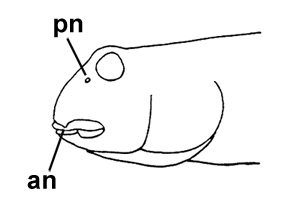
cephalic sensory and nasal pores of Periophthalmus spp.: an= anterior nostril; pn= posterior nostril
(modified from Murdy, 1989)* - * with permission
|




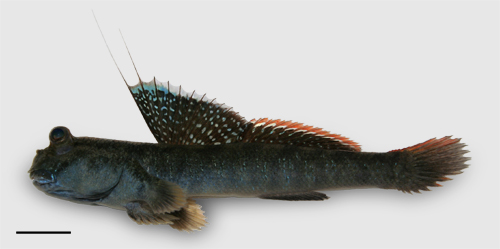
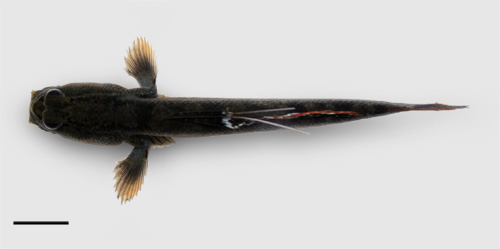
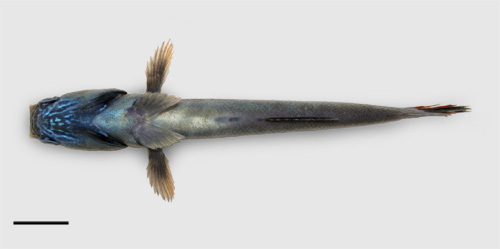
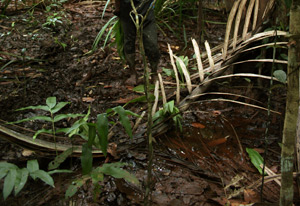
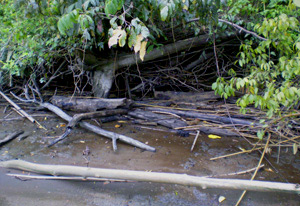

![]()